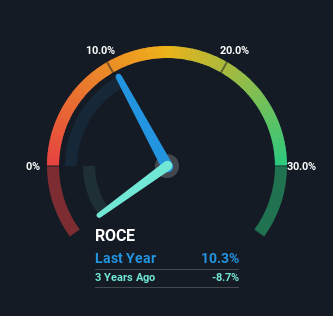To find a multi-bagger stock, what are the underlying trends we should look for in a business? In a perfect world, we'd like to see a company investing more capital into its business and ideally the returns earned from that capital are also increasing. Put simply, these types of businesses are compounding machines, meaning they are continually reinvesting their earnings at ever-higher rates of return. So, when we ran our eye over United Airlines Holdings' (NASDAQ:UAL) trend of ROCE, we liked what we saw.
Understanding Return On Capital Employed (ROCE)
If you haven't worked with ROCE before, it measures the 'return' (pre-tax profit) a company generates from capital employed in its business. Analysts use this formula to calculate it for United Airlines Holdings:
Return on Capital Employed = Earnings Before Interest and Tax (EBIT) ÷ (Total Assets - Current Liabilities)
0.10 = US$5.2b ÷ (US$74b - US$23b) (Based on the trailing twelve months to December 2024).
Thus, United Airlines Holdings has an ROCE of 10%. In absolute terms, that's a pretty normal return, and it's somewhat close to the Airlines industry average of 8.8%.
See our latest analysis for United Airlines Holdings

In the above chart we have measured United Airlines Holdings' prior ROCE against its prior performance, but the future is arguably more important. If you're interested, you can view the analysts predictions in our free analyst report for United Airlines Holdings .
So How Is United Airlines Holdings' ROCE Trending?
While the returns on capital are good, they haven't moved much. The company has employed 35% more capital in the last five years, and the returns on that capital have remained stable at 10%. 10% is a pretty standard return, and it provides some comfort knowing that United Airlines Holdings has consistently earned this amount. Over long periods of time, returns like these might not be too exciting, but with consistency they can pay off in terms of share price returns.
Our Take On United Airlines Holdings' ROCE
The main thing to remember is that United Airlines Holdings has proven its ability to continually reinvest at respectable rates of return. In light of this, the stock has only gained 33% over the last five years for shareholders who have owned the stock in this period. So to determine if United Airlines Holdings is a multi-bagger going forward, we'd suggest digging deeper into the company's other fundamentals.
United Airlines Holdings does have some risks though, and we've spotted 2 warning signs for United Airlines Holdings that you might be interested in.
While United Airlines Holdings may not currently earn the highest returns, we've compiled a list of companies that currently earn more than 25% return on equity. Check out this free list here.
New: AI Stock Screener & Alerts
Our new AI Stock Screener scans the market every day to uncover opportunities.
• Dividend Powerhouses (3%+ Yield)
• Undervalued Small Caps with Insider Buying
• High growth Tech and AI Companies
Or build your own from over 50 metrics.
Have feedback on this article? Concerned about the content? Get in touch with us directly. Alternatively, email editorial-team (at) simplywallst.com.
This article by Simply Wall St is general in nature. We provide commentary based on historical data and analyst forecasts only using an unbiased methodology and our articles are not intended to be financial advice. It does not constitute a recommendation to buy or sell any stock, and does not take account of your objectives, or your financial situation. We aim to bring you long-term focused analysis driven by fundamental data. Note that our analysis may not factor in the latest price-sensitive company announcements or qualitative material. Simply Wall St has no position in any stocks mentioned.
About NasdaqGS:UAL
United Airlines Holdings
Through its subsidiaries, provides air transportation services in the United States, Canada, Atlantic, the Pacific, and Latin America.
Acceptable track record with mediocre balance sheet.
Similar Companies
Market Insights
Community Narratives




